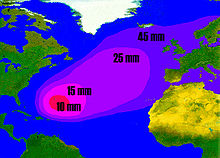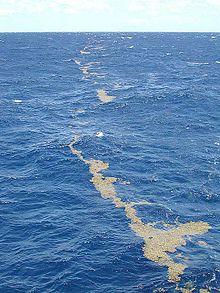- Sargasso Sea
-
The Sargasso Sea is a region in the middle of the North Atlantic Ocean, surrounded by ocean currents. It is bounded on the west by the Gulf Stream; on the north, by the North Atlantic Current; on the east, by the Canary Current; and on the south, by the North Atlantic Equatorial Current. This system of currents forms the North Atlantic Subtropical Gyre. All the currents deposit the marine plants and garbage they carry into this sea.
The Sargasso Sea is 700 statute miles wide and 2,000 statute miles long (1,100 km wide and 3,200 km long). It stretches from roughly 70 degrees west to 40 degrees west, and from 25 degrees north to 35 degrees north. Bermuda is near the western fringes of the sea. The Sargasso Sea is the only "sea" without shores.[1] The ocean water in the Sargasso Sea is distinctive for its deep blue color and exceptional clarity, with underwater visibility of up to 200 feet (61 m).[2]
Contents
History
Portuguese sailors were among the first to discover this region in the 15th century, naming it after the Sargassum seaweed growing there (sargaço / sargasso in Portuguese).[3] However, the sea may have been known to earlier mariners, as a poem by the late 4th century AD author, Rufus Festus Avienus, describes a portion of the Atlantic as being covered with seaweed, citing a now-lost account by the 5th-century BC Carthaginian explorer Himilco the Navigator. Christopher Columbus and his men also noted the Saragasso Sea, and brought reports of the masses of seaweed on the surface.[4]
Ecology
The Sargasso Sea is home to seaweed of the genus Sargassum, which floats en masse on the surface there. The sargassum is not a threat to shipping, and historic incidents of sailing ships being trapped there are due to the often calm winds of the horse latitudes.[5]
The Sargasso Sea also plays a major role in the migration of the European eel and the American eel. The larvae of both species hatch there and go to Europe or the East Coast of North America. Later in life, they try to return to the Sargasso Sea to lay eggs. It is also believed that after hatching, young Loggerhead Sea Turtles use currents, such as the Gulf Stream to travel to the Sargasso Sea, where they use the Sargassum as cover from predation until they are mature.[6]
The Sargasso Sea was the subject of a recent metagenomics effort called the Global Ocean Sampling (GOS) survey by J. Craig Venter and others, to evaluate the diversity of microbial life there. The results have indicated that, contrary to previous theories, the area has a wide variety of prokaryotic life.[citation needed]
Owing to surface currents, the Sargasso accumulates a high concentration of non-biodegradable plastic waste.[7] The huge North Atlantic Garbage Patch is similar to another ocean phenomenon, the Great Pacific Garbage Patch.
Depictions in popular culture
The Sargasso Sea is often portrayed in literature and the media as an area of mystery.[8]
The Sargasso Sea features in classic fantasy stories by William Hope Hodgson, such as his novel The Boats of the "Glen Carrig" (1907), Victor Appleton's Don Sturdy novel, Don Sturdy in the Port of Lost Ships: Or, Adrift in the Sargasso Sea, and several related short stories. Jules Verne's 20,000 Leagues Under the Seas describes the Sargasso Sea and gives an account of its formation.[9]
Edwin Corley's novel, Sargasso, revolves around a fictional account of Apollo 19 splashing down in the Sargasso sea empty. In Marvel 1602, it is where the Fantastick Four gained their powers. Jean Rhys's novel Wide Sargasso Sea plays with the idea that a woman can become lost in her own society and thus driven out of her mind, a la Bronte's 'mad woman in the attic'. Fred Andrew's mystery novel Plato's Pond [10] features the fictitious land of Gaia, which is a continent in the middle of the Sargassum Sea.
Steve Alten's Loch Ness-related novel The Loch revolves around an unknown species of animal being encountered in the depths of the Sargasso Sea. Sargasso is also depicted in the book Остров Погибших Кораблей(Isle of Crashed Ships) by Aleksander Belayev (Александр Беляев).
The Sargasso Sea was the venue for the Doc Savage adventure "The Sargasso Ogre" written by Lester Dent under the pseudonym Kenneth Robeson and published in the October 1933 issue of the Doc Savage pulp magazine.[11][12]
The 1923 silent film The Isle of Lost Ships an atmospheric adventure from director Maurice Tourneur takes place in the Sargasso Sea. The film was based on Crittenden Marriott's 1909 novel The Isle of Dead Ships. The Isle of Lost Ships is now a lost film.
The 1968 movie The Lost Continent was set in a highly fictionalized Sargasso Sea where Spanish galleons, trapped for centuries in seaweed, are found in modern times, along with a society of descendants of Conquistadores and sea monsters.
John Abercrombie & Ralph Towner collaborated on a Jazz album named Sargasso Sea, recorded in May 1976.
British Post Rock group Pram produced a an album in 1995 entitled Sargasso Sea.
The video for Modest Mouse's "Dashboard" involves a sailor's tale of being lost in the Sargasso in which he loses a hand and is rescued by an island tribe of musical performers who replace his missing hand with a microphone.
Lotus recorded a live album in 2007 entitled Escaping Sargasso Sea.
Wide Sargasso Sea, a 1997 opera adaptation of Jean Rhys' novel, with music by Brian Howard, was directed by Douglas Horton, and produced by Chamber Made.
"Sargasso Sea" is a song by Scale the Summit on their 2009 release, "Carving Desert Canyons".
Stevie Nicks's 2011 release In Your Dreams included a song entitled "Wide Sargasso Sea", co-written by Nicks and Dave Stewart.
The science fiction 4X game Sid Meier's Alpha Centauri, one of the landmarks on the planet Chiron is called "New Sargasso", a sea whose surface is covered by the native xenofungus.
References
- ^ "Flint Institute of Arts Vol 2 No 2". http://web.mac.com/flintartsed/Homeschool/artreachresources_files/AR2_2_Oct07.pdf.
- ^ "Sargasso Sea". World Book. 15. Field Enterprises. 1958.
- ^ "Wide Sargasso Sea". Book Drum. http://www.bookdrum.com/books/wide-sargasso-sea/9780140818031/setting.html.
- ^ "The Sargasso Sea". BBC - Homepage. BBC. http://www.bbc.co.uk/nature/blueplanet/infobursts/sargasso_bg.shtml. Retrieved 6 June 2011.
- ^ "Sargasso". Straight Dope. http://www.straightdope.com/mailbag/msargasso.html.
- ^ "Turtles return home after UK stay". BBC News. 2008-06-30. http://news.bbc.co.uk/1/hi/sci/tech/7477519.stm. Retrieved 2010-05-23.
- ^ "The trash vortex". Greenpeace. http://www.greenpeace.org/international/campaigns/oceans/pollution/trash-vortex. Retrieved 2008-04-20.
- ^ Ruth Heller (2000). A Sea Within a Sea: Secrets of the Sargasso. Price Stern Sloan. ISBN 978-0448424170.
- ^ Jules Verne (trans. by William Butcher) (1870/2001). 20,000 Leagues Under the Seas. Oxford University Press. ISBN 0-19-282839-8. http://www.ibiblio.org/julesverne/books/20t.htm.
- ^ Kemper Conseil Publishing
- ^ "The Sargasso Ogre". The Fantastic Adventures of Doc Savage. http://www.supremeadventurer.com/18story.html. Retrieved 2009-09-04.
- ^ Dent, Lester (2007). Doc Savage Reprint #7: The Lost Oasis and The Sargasso Ogre. Nostalgia Ventures. ISBN 1-9328-0671-7.
External links
- Skeptoid #132: The Sargasso Sea and the Pacific Garbage Patch at Skeptoid
- What's the story on the Sargasso Sea? (The Straight Dope)
- Photos of organisms living in the Sargasso Sea
Ocean currents and gyres Currents - East Greenland
- Norwegian
- Transpolar Drift Stream
- Agulhas
- Angola
- Antilles
- Azores
- Baffin Island
- Benguela
- Brazil
- Canary
- Cape Horn
- Caribbean
- East Greenland
- East Iceland
- Falkland
- Florida
- Guinea
- Gulf Stream
- Irminger
- Labrador
- Lomonosov
- Loop
- North Atlantic
- North Brazil
- North Equatorial
- Norwegian
- Portugal
- Slope Jet
- South Atlantic
- South Equatorial
- Spitsbergen
- West Greenland
- Agulhas
- East Madagascar
- Equatorial Counter Current
- Indian Monsoon Current
- Indonesian Throughflow
- Leeuwin
- Madagascar
- Mozambique
- Somali
- South Australian
- South Equatorial
- West Australian
Gyres Major gyres- Indian Ocean Gyre
- North Atlantic Gyre
- South Atlantic Gyre
- North Pacific Gyre
- South Pacific Gyre
Other gyres- Beaufort Gyre
- Ross Gyre
- Weddell Gyre
Related Categories:- Seas of the Atlantic Ocean
- Bermuda Triangle
Wikimedia Foundation. 2010.


